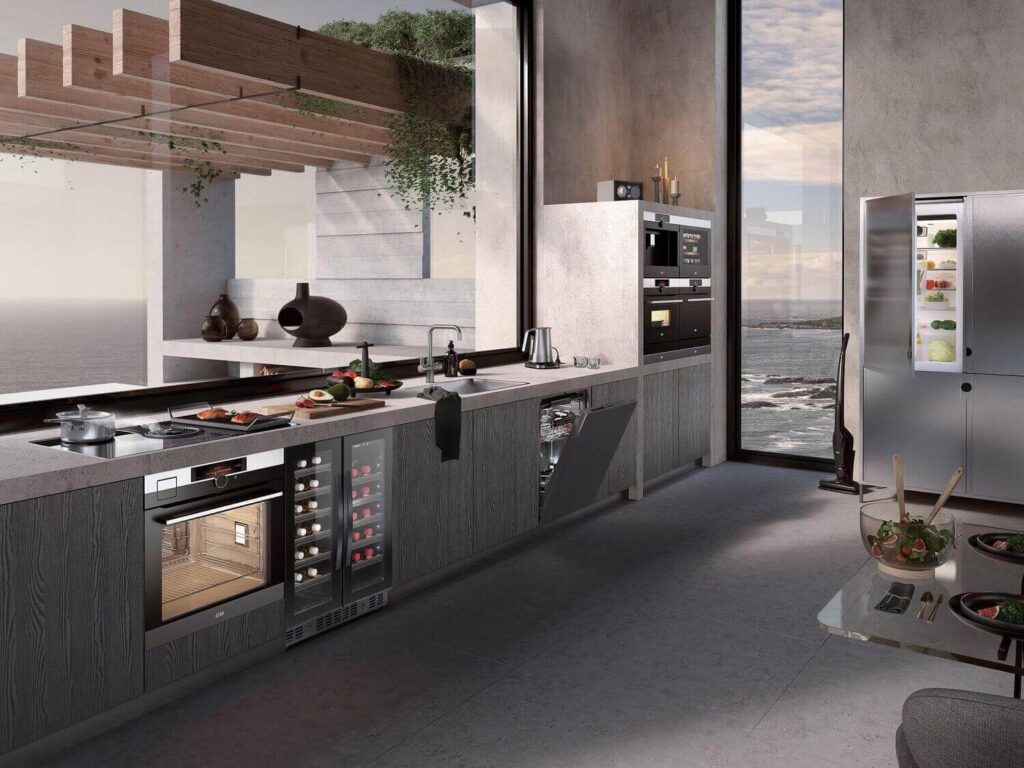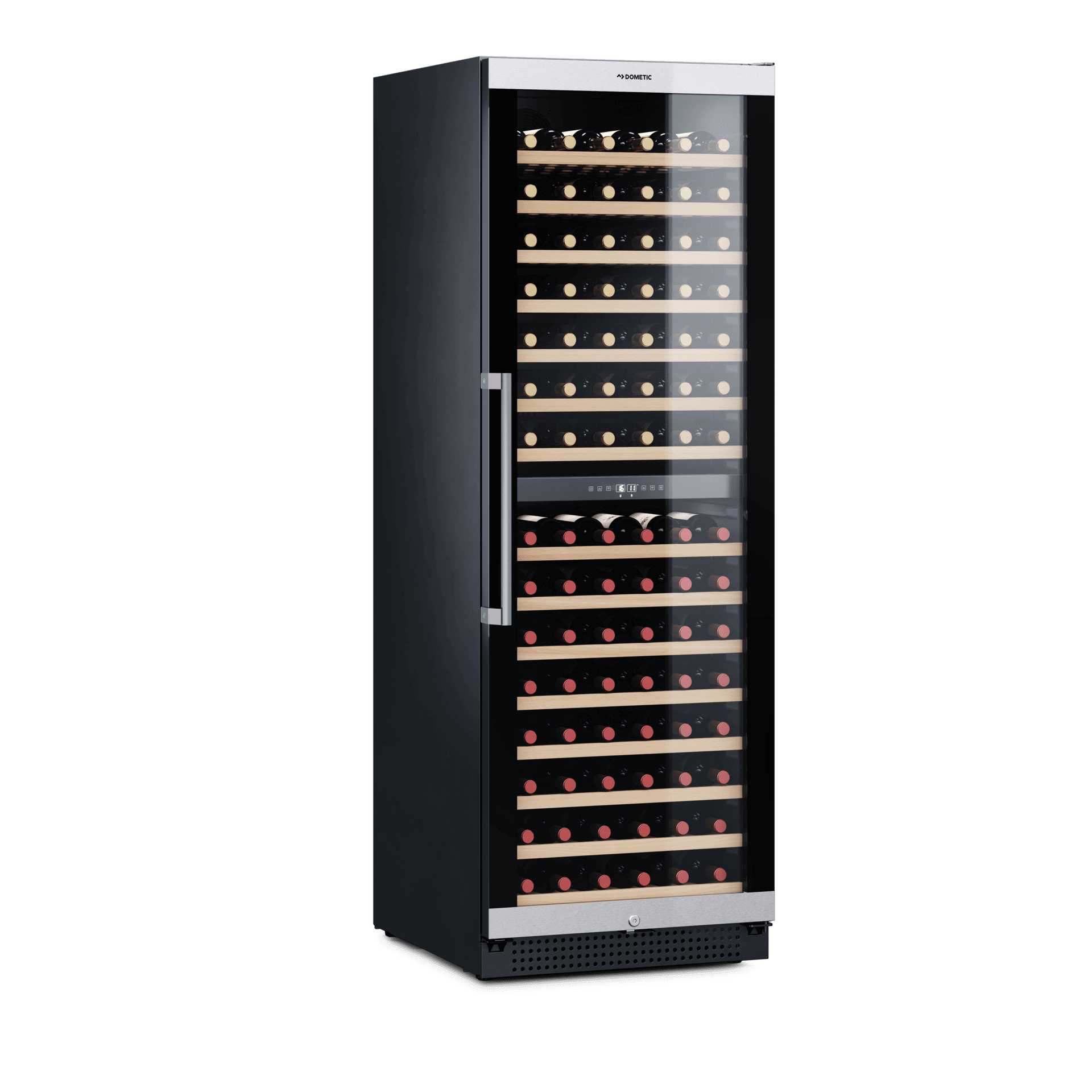
วิธีเก็บไวน์ที่เปิดแล้วรวมถึงไวน์ขวดใหม่
ไม่ว่าคุณจะเป็นผู้ชื่นชอบดื่มไวน์เป็นประจำ หรือชอบจิบไวน์เป็นครั้งคราว การรู้วิธีจัดเก็บไวน์ก่อน และ วิธีเก็บไวน์ที่เปิดแล้ว ถือเป็นสิ่งสำคัญเพื่อให้แน่ใจว่าจะได้รสชาติและกลิ่นหอมที่ดีที่สุด
การจัดเก็บไวน์ที่เหมาะสมสามารถสร้างความแตกต่างให้กับประสบการณ์การดื่มไวน์ของคุณได้อย่างมาก ในบทความนี้ เราจะสำรวจขั้นตอนและเคล็ดลับเพื่อช่วยให้คุณรักษาไวน์ให้อยู่ในสภาพที่เหมาะสม ตั้งแต่วินาทีแรกที่ไวน์เข้าบ้านไปจนถึงหยดสุดท้ายในแก้ว
1. อุณหภูมิมีความสำคัญ
– ก่อนเปิด: เก็บขวดไวน์ไว้ในที่เย็น แสงเข้าถึงน้อยรวมถึงมีอุณหภูมิสม่ำเสมอประมาณ 55°F (13°C) หลีกเลี่ยงความผันผวนของอุณหภูมิ และความชื้น
เนื่องจากอาจทำให้ไวน์ด้อยคุณภาพลงและเน่าเสียได้ (แนะนำเป็นตู้แช่ไวน์หรือห้องเก็บไวน์)
– หลังจากเปิด: หากคุณเปิดขวดและดื่มไม่หมดในคราวเดียว ให้ปิดขวดให้แน่นแล้วเก็บไว้ในตู้แช่ไวน์ที่อุณหภูมิประมาณ 55-65°F (13-18°C) สำหรับไวน์แดง
หรือ 45-50° F (7-10°C) สำหรับไวน์ขาว ควรบริโภคภายใน 2-3 วันเพื่อคุณภาพที่ดีที่สุด
2. การควบคุมความชื้น
– ก่อนเปิด: รักษาระดับความชื้นไว้ประมาณ 70% เพื่อป้องกันไม่ให้จุกไม้ก๊อกแห้ง และป้องกันไม่ให้อากาศซึมเข้าไปในขวด
– หลังจากเปิด: การควบคุมความชื้นมีความสำคัญน้อยลงหลังเปิด แต่ยังคงควรรักษาความชื้นด้วยไม้ก๊อกเพื่อรักษาการปิดผนึก
3. หลีกเลี่ยงการสั่นสะเทือน
– ก่อนเปิด: เก็บขวดไวน์ให้ห่างจากอุปกรณ์ที่ทำให้เกิดการสั่นสะเทือน เช่น ตู้เย็นและเครื่องซักผ้า เนื่องจากการสั่นสะเทือนอาจรบกวนตะกอนในไวน์ได้
– หลังจากเปิด: ค่อยๆ จับขวดที่เปิดอยู่เพื่อไม่ให้รบกวนตะกอนที่อาจเกาะอยู่
4. หลีกเลี่ยงแสง UV
– ก่อนเปิด: เก็บไวน์ไว้ในที่มืด หรือใช้ชั้นวาง หรือฝาครอบไวน์ที่ทนต่อรังสียูวีเพื่อป้องกันแสง ซึ่งอาจทำให้ไวน์รสชาติและกลิ่นสัมผัสด้อยลง
– หลังจากเปิด: ใช้จุกปิดไวน์หรือระบบเก็บรักษาไวน์ที่ช่วยลดแสงของไวน์ให้เหลือน้อยที่สุด เช่น ตู้ไวน์ หรือห้องเก็บไวน์ใต้ดิน
5. เก็บรักษาไวน์ในที่ที่เหมาะสม
– ก่อนเปิด: วิธีเก็บไวน์ที่เปิดแล้วเก็บขวดไวน์ในแนวนอน เพื่อรักษาความชื้นของจุกไม้ก๊อกและปิดผนึกให้แน่น
– หลังเปิด: เก็บขวดที่เปิดแล้วไว้ตั้งตรง เพื่อลดพื้นที่ผิวที่สัมผัสกับออกซิเจน
6. ควบคุมกลิ่น
– ก่อนเปิด: หลีกเลี่ยงการเก็บไวน์ไว้ใกล้สารที่มีกลิ่นแรง เนื่องจากไวน์สามารถดูดซับกลิ่นได้
– หลังเปิด: ปิดขวดด้วยจุกสุญญากาศเพื่อป้องกันไม่ให้ไวน์ดูดซับกลิ่นในตู้เย็น
7. เก็บรักษาด้วยอุปกรณ์เฉพาะสำหรับการแช่ไวน์
– ก่อนเปิด : ควรลองพิจารณาลงทุนใน ห้องใต้ดิน หรือ ตู้แช่ไวน์ เพราะตู้แช่ไวน์ที่ดีจะช่วยควบคุมอุณหภูมิและความชื้นที่แม่นยำ ทำให้ช่วยรักษาคุณภาพและรสชาติทั้งไวน์ขาวและไวน์แดง โดยเฉพาะตู้แช่ไวน์ 2 โซนอุณหภูมิ ซึ่งเหมาะสำหรับแช่ทั้งไวน์ขาวและไวน์แดงในตู้เดียวกัน โดยแบ่งโซนด้านบนสำหรับแช่ไวน์ขาว(อุณหภูมิต่ำกว่า) ด้านล่างสำหรับแช่ไวน์แดง(อุณหภูมิสูงกว่า) เนื่องจากโดยปกติแล้วCompressorที่คอยทำความเย็นจะอยู่ด้านบน เลยทำให้ตู้โซนด้านบนจะมีอุณหภูมิที่ต่ำกว่าเลยเหมาะสำหรับแช่ไวน์ขาวในโซนด้านบน

แนะนำตู้แช่ไวน์นำเข้าจากสวีเดนรุ่นต่างๆของทางร้าน
Dometic winecellar by orsgo.com
D154F ตู้แช่ไวน์ 154 ขวด
C154F ตู้แช่ไวน์ 154 ขวด
C46B ตู้แช่ไวน์ 46 ขวด
D42F ตู้แช่ไวน์ 42 ขวด
D46B ตู้แช่ไวน์ 46 ขวด
C18B ตู้แช่ไวน์ 18 ขวด
– วิธีเก็บไวน์ที่เปิดแล้ว : ใช้ปั๊มสุญญากาศ สเปรย์ก๊าซเฉื่อย หรือระบบถนอมไวน์ เพื่อกำจัดอากาศและยืดอายุไวน์ที่เปิดของคุณ
8. เสิร์ฟในอุณหภูมิที่เหมาะสม
– ก่อนเปิด: ปล่อยให้ไวน์มีอุณหภูมิที่เหมาะสมในการเสิร์ฟก่อนเปิดจุก โดยทั่วไปแล้วสีแดงจะมีรสชาติดีที่สุดที่อุณหภูมิอุ่นกว่าสีขาวเล็กน้อย
– หลังเปิด: เสิร์ฟไวน์ตามอุณหภูมิที่แนะนำตามประเภทของไวน์ เพื่อให้ได้รสชาติและกลิ่นที่ครบถ้วน
9. ฉลากและที่เปิดขวด
– ก่อนเปิด: ควรดูแลรักษาคอลเลกชันไวน์อย่างเป็นระเบียบ ติดฉลากขวดพร้อมวันที่ซื้อและข้อมูลอื่น ๆ ที่เกี่ยวข้อง
– หลังจากเปิดขวด: จดวันที่ที่คุณเปิดขวดเพื่อติดตามความสดของขวด
10. รู้ว่าเมื่อไหร่ควรบอกลาไวน์
– ก่อนเปิด: ไวน์บางชนิดไม่ได้รสชาติดีขึ้นเมื่อเก็บนานๆ การศึกษาระยะเวลาการบ่มของไวน์แต่ละขวดช่วยได้ ดังนั้นอย่าลังเลในการหยิบไวน์ออกจากตู้แช่ไวน์และเพลิดเพลินไปกับไวน์ให้เติมเต็มค่ำคืนแสนพิเศษ
– หลังจากเปิด: หากไวน์ผ่านช่วงเวลาที่ดีที่สุดหรือสูญเสียรสชาติไปแล้ว ให้พิจารณานำไปใช้ปรุงอาหารหรือทิ้งไป
โดยสรุป การเก็บรักษาไวน์อย่างเหมาะสมทำได้โดยใช้วิธีและเครื่องมือที่เหมาะสม สามารถช่วยเพิ่มประสบการณ์การดื่มไวน์ของคุณได้ ไม่ว่าคุณจะดื่มไวน์ขวดพิเศษหรือเพลิดเพลินกับอาหารค่ำสักแก้ว โดยทริคสั้นๆ 10 ข้อด้านบน สามารถมั่นใจได้เลยว่าไวน์ของคุณจะยังคงคุณภาพดีที่สุดตั้งแต่วินาทีที่คุณนำกลับบ้านไปจนถึงจิบหยดสุดท้ายในแก้วของคุณ
How to Properly Store and Preserve Wine Before and After Opening
Whether you’re a wine enthusiast or an occasional sipper, knowing how to store and preserve wine before and after opening is essential to ensure the best possible taste and aroma. Proper wine storage and handling can make a significant difference in your wine-drinking experience. In this guide, we’ll explore the steps and tips to help you keep your wine in optimal condition, from the moment it enters your home to the last drop in your glass.
1. Temperature Matters
- Before Opening: Store wine bottles on their sides in a cool, dark place at a consistent temperature of around 55°F (13°C). Avoid temperature fluctuations, as they can cause wine to age prematurely and spoil.
- After Opening: If you can’t finish the bottle in one sitting, recork it tightly and store it in the refrigerator at a temperature of about 55-65°F (13-18°C) for red wine or 45-50°F (7-10°C) for white wine. Consume within a few days for the best quality.
2. Humidity Control
- Before Opening: Maintain humidity levels around 70% to prevent corks from drying out and allowing air to seep into the bottle.
- After Opening: Humidity control is less critical after opening, but it’s still a good practice to keep the cork moist to maintain the seal.
3. Avoid Vibrations
- Before Opening: Keep wine bottles away from appliances that produce vibrations, such as refrigerators and washing machines, as vibrations can disturb the sediment in wine.
- After Opening: Handle the open bottle gently to avoid disturbing any sediment that may have settled.
4. Shield from Light
- Before Opening: Store wine in a dark place or use UV-resistant wine racks or covers to protect it from light, which can cause wine to age prematurely.
- After Opening: Use wine stoppers or wine preservation systems that minimize the wine’s exposure to light.
5. Maintain Proper Position
- Before Opening: Store wine bottles horizontally to keep the cork moist and create a tight seal.
- After Opening: Store open bottles upright to minimize the surface area exposed to oxygen.
6. Control Odors
- Before Opening: Avoid storing wine near strong-smelling substances as wine can absorb odors.
- After Opening: Seal the bottle with an airtight stopper to prevent wine from absorbing fridge odors.
7. Preserve with Wine Accessories
- Before Opening: Consider investing in wine coolers, cellars, or wine fridges with precise temperature and humidity controls.
- After Opening: Use vacuum pumps, inert gas sprays, or wine preservation systems to remove air and extend the life of your open wine.
8. Serve at the Right Temperature
- Before Opening: Allow wine to reach its ideal serving temperature before uncorking. Reds generally taste best at slightly warmer temperatures than whites.
- After Opening: Serve wine at the recommended temperature for its type to enjoy the full range of flavors and aromas.
9. Label and Date Bottles
- Before Opening: Maintain an organized wine collection, labeling bottles with their purchase date and other relevant information.
- After Opening: Jot down the date you opened the bottle to keep track of its freshness.
10. Know When to Say Goodbye
- Before Opening: Not all wines improve with age. Research the aging potential of the wine you purchase, and don’t hesitate to enjoy it at its peak.
- After Opening: If a wine has passed its prime or lost its flavors, consider using it for cooking or discard it.
In conclusion, proper wine storage and preservation practices can enhance your wine-drinking experience, whether you’re savoring a special bottle or enjoying a glass with dinner. By following these guidelines, you can ensure that your wine remains at its best from the moment you bring it home to the last sip in your glass. Cheers!
